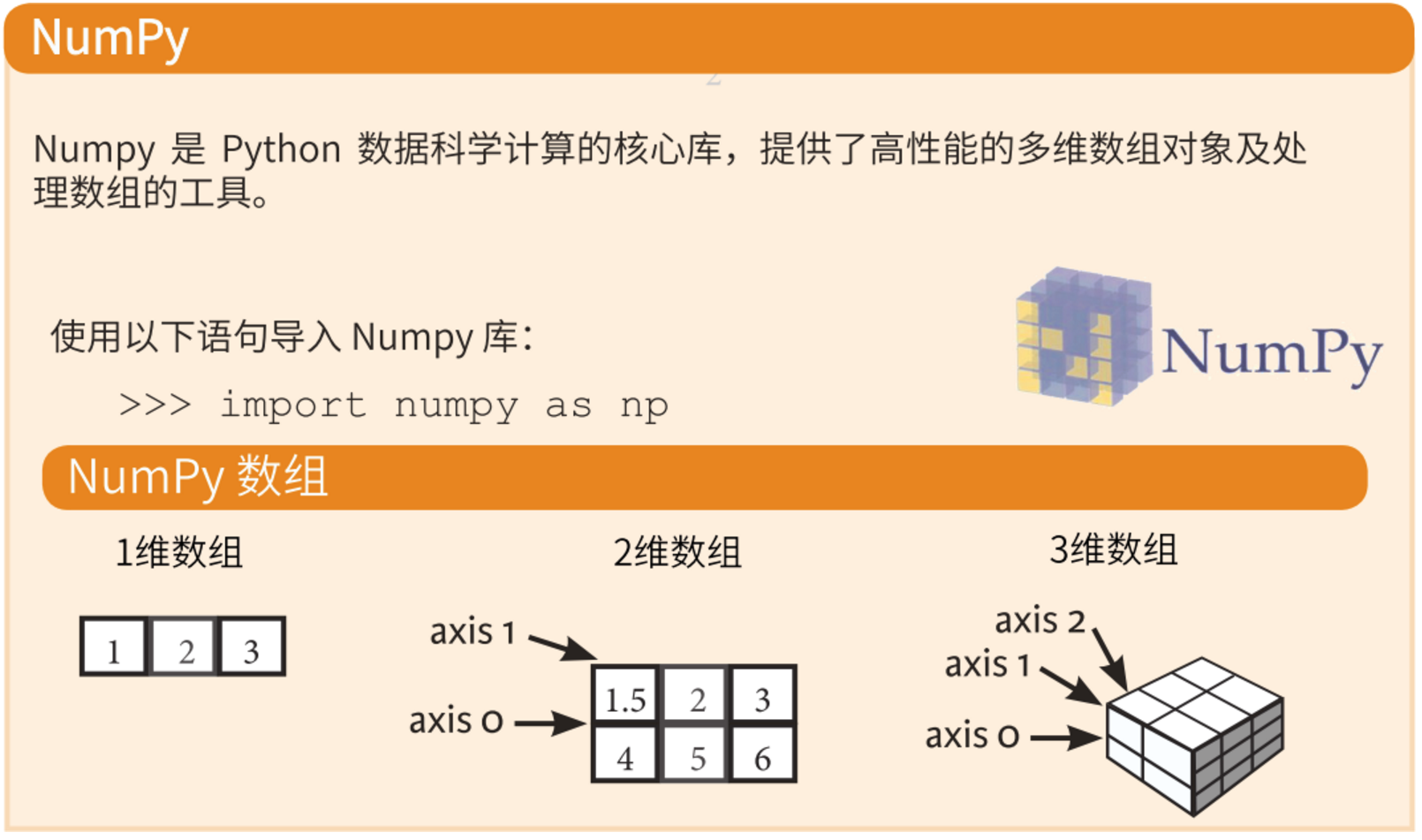背景
什么是 NumPy 呢?

NumPy 这个词来源于两个单词 – Numerical和Python。其是一个功能强大的 Python 库,可以帮助程序员轻松地进行数值计算,通常应用于以下场景:
- 执行各种数学任务,如:数值积分、微分、内插、外推等。因此,当涉及到数学任务时,它形成了一种基于 Python 的 MATLAB 的快速替代。
- 计算机中的图像表示为多维数字数组。NumPy 提供了一些优秀的库函数来快速处理图像。例如,镜像图像、按特定角度旋转图像等。
- 在编写机器学习算法时,需要对矩阵进行各种数值计算。如:矩阵乘法、求逆、换位、加法等。NumPy 数组用于存储训练数据和机器学习模型的参数。
逻辑函数
真值测试
numpy.all(a, axis=None, out=None, keepdims=np._NoValue)Test whether all array elements along a given axis evaluate to True.numpy.any(a, axis=None, out=None, keepdims=np._NoValue)Test whether any array element along a given axis evaluates to True.
import numpy as npa = np.array([0, 4, 5])
b = np.copy(a)
print(np.all(a == b)) # True
print(np.any(a == b)) # True
b[0] = 1
print(np.all(a == b)) # False
print(np.any(a == b)) # Trueprint(np.all([1.0, np.nan])) # True
print(np.any([1.0, np.nan])) # Truea = np.eye(3)
print(np.all(a, axis=0)) # [False False False]
print(np.any(a, axis=0)) # [ True True True]
逻辑运算
numpy.logical_not(x, *args, **kwargs)Compute the truth value of NOT x element-wise.numpy.logical_and(x1, x2, *args, **kwargs)Compute the truth value of x1 AND x2 element-wise.numpy.logical_or(x1, x2, *args, **kwargs)Compute the truth value of x1 OR x2 element-wise.numpy.logical_xor(x1, x2, *args, **kwargs)Compute the truth value of x1 XOR x2, element-wise.
【例】
import numpy as npx = np.arange(5)
print(np.logical_not(3))
# False
print(np.logical_not([True, False, 0, 1]))
# [False True True False]
print(np.logical_not(x < 3))
# [False False False True True]print(np.logical_and(True, False))
# False
print(np.logical_and([True, False], [True, False]))
# [ True False]
print(np.logical_and(x > 1, x < 4))
# [False False True True False]print(np.logical_or(True, False))
# True
print(np.logical_or([True, False], [False, False]))
# [ True False]
print(np.logical_or(x < 1, x > 3))
# [ True False False False True]print(np.logical_xor(True, False))
# True
print(np.logical_xor([True, True, False, False], [True, False, True, False]))
# [False True True False]
print(np.logical_xor(x < 1, x > 3))
# [ True False False False True]
print(np.logical_xor(0, np.eye(2)))
# [[ True False]
# [False True]]
对照
numpy.greater(x1, x2, *args, **kwargs)Return the truth value of (x1 > x2) element-wise.numpy.greater_equal(x1, x2, *args, **kwargs)Return the truth value of (x1 >= x2) element-wise.numpy.equal(x1, x2, *args, **kwargs)Return (x1 == x2) element-wise.numpy.not_equal(x1, x2, *args, **kwargs)Return (x1 != x2) element-wise.numpy.less(x1, x2, *args, **kwargs)Return the truth value of (x1 < x2) element-wise.numpy.less_equal(x1, x2, *args, **kwargs)Return the truth value of (x1 =< x2) element-wise.
【例】numpy对以上对照函数进行了运算符的重载。
import numpy as npx = np.array([1, 2, 3, 4, 5, 6, 7, 8])y = x > 2
print(y)
print(np.greater(x, 2))
# [False False True True True True True True]y = x >= 2
print(y)
print(np.greater_equal(x, 2))
# [False True True True True True True True]y = x == 2
print(y)
print(np.equal(x, 2))
# [False True False False False False False False]y = x != 2
print(y)
print(np.not_equal(x, 2))
# [ True False True True True True True True]y = x < 2
print(y)
print(np.less(x, 2))
# [ True False False False False False False False]y = x <= 2
print(y)
print(np.less_equal(x, 2))
# [ True True False False False False False False]
【例】
import numpy as npx = np.array([[11, 12, 13, 14, 15],[16, 17, 18, 19, 20],[21, 22, 23, 24, 25],[26, 27, 28, 29, 30],[31, 32, 33, 34, 35]])
y = x > 20
print(y)
print(np.greater(x, 20))
# [[False False False False False]
# [False False False False False]
# [ True True True True True]
# [ True True True True True]
# [ True True True True True]]y = x >= 20
print(y)
print(np.greater_equal(x, 20))
# [[False False False False False]
# [False False False False True]
# [ True True True True True]
# [ True True True True True]
# [ True True True True True]]y = x == 20
print(y)
print(np.equal(x, 20))
# [[False False False False False]
# [False False False False True]
# [False False False False False]
# [False False False False False]
# [False False False False False]]y = x != 20
print(y)
print(np.not_equal(x, 20))
# [[ True True True True True]
# [ True True True True False]
# [ True True True True True]
# [ True True True True True]
# [ True True True True True]]y = x < 20
print(y)
print(np.less(x, 20))
# [[ True True True True True]
# [ True True True True False]
# [False False False False False]
# [False False False False False]
# [False False False False False]]y = x <= 20
print(y)
print(np.less_equal(x, 20))
# [[ True True True True True]
# [ True True True True True]
# [False False False False False]
# [False False False False False]
# [False False False False False]]
【例】
import numpy as npnp.random.seed(20200611)
x = np.array([[11, 12, 13, 14, 15],[16, 17, 18, 19, 20],[21, 22, 23, 24, 25],[26, 27, 28, 29, 30],[31, 32, 33, 34, 35]])y = np.random.randint(10, 40, [5, 5])
print(y)
# [[32 28 31 33 37]
# [23 37 37 30 29]
# [32 24 10 33 15]
# [27 17 10 36 16]
# [25 32 23 39 34]]z = x > y
print(z)
print(np.greater(x, y))
# [[False False False False False]
# [False False False False False]
# [False False True False True]
# [False True True False True]
# [ True False True False True]]z = x >= y
print(z)
print(np.greater_equal(x, y))
# [[False False False False False]
# [False False False False False]
# [False False True False True]
# [False True True False True]
# [ True True True False True]]z = x == y
print(z)
print(np.equal(x, y))
# [[False False False False False]
# [False False False False False]
# [False False False False False]
# [False False False False False]
# [False True False False False]]z = x != y
print(z)
print(np.not_equal(x, y))
# [[ True True True True True]
# [ True True True True True]
# [ True True True True True]
# [ True True True True True]
# [ True False True True True]]z = x < y
print(z)
print(np.less(x, y))
# [[ True True True True True]
# [ True True True True True]
# [ True True False True False]
# [ True False False True False]
# [False False False True False]]z = x <= y
print(z)
print(np.less_equal(x, y))
# [[ True True True True True]
# [ True True True True True]
# [ True True False True False]
# [ True False False True False]
# [False True False True False]]
【例】
import numpy as npx = np.array([[11, 12, 13, 14, 15],[16, 17, 18, 19, 20],[21, 22, 23, 24, 25],[26, 27, 28, 29, 30],[31, 32, 33, 34, 35]])np.random.seed(20200611)
y = np.random.randint(10, 50, 5)print(y)
# [32 37 30 24 10]z = x > y
print(z)
print(np.greater(x, y))
# [[False False False False True]
# [False False False False True]
# [False False False False True]
# [False False False True True]
# [False False True True True]]z = x >= y
print(z)
print(np.greater_equal(x, y))
# [[False False False False True]
# [False False False False True]
# [False False False True True]
# [False False False True True]
# [False False True True True]]z = x == y
print(z)
print(np.equal(x, y))
# [[False False False False False]
# [False False False False False]
# [False False False True False]
# [False False False False False]
# [False False False False False]]z = x != y
print(z)
print(np.not_equal(x, y))
# [[ True True True True True]
# [ True True True True True]
# [ True True True False True]
# [ True True True True True]
# [ True True True True True]]z = x < y
print(z)
print(np.less(x, y))
# [[ True True True True False]
# [ True True True True False]
# [ True True True False False]
# [ True True True False False]
# [ True True False False False]]z = x <= y
print(z)
print(np.less_equal(x, y))
# [[ True True True True False]
# [ True True True True False]
# [ True True True True False]
# [ True True True False False]
# [ True True False False False]]
numpy.isclose(a, b, rtol=1.e-5, atol=1.e-8, equal_nan=False)Returns a boolean array where two arrays are element-wise equal within a tolerance.numpy.allclose(a, b, rtol=1.e-5, atol=1.e-8, equal_nan=False)Returns True if two arrays are element-wise equal within a tolerance.numpy.all(isclose(a, b, rtol=rtol, atol=atol, equal_nan=equal_nan))
The tolerance values are positive, typically very small numbers. The relative difference (rtol * abs(b)) and the absolute difference atol are added together to compare against the absolute difference between a and b.
判断是否为True的计算依据:
np.absolute(a - b) <= (atol + rtol * absolute(b))- atol:float,绝对公差。
- rtol:float,相对公差。
NaNs are treated as equal if they are in the same place and if equal_nan=True. Infs are treated as equal if they are in the same place and of the same sign in both arrays.
【例】比较两个数组是否可以认为相等。
import numpy as npx = np.isclose([1e10, 1e-7], [1.00001e10, 1e-8])
print(x) # [ True False]x = np.allclose([1e10, 1e-7], [1.00001e10, 1e-8])
print(x) # Falsex = np.isclose([1e10, 1e-8], [1.00001e10, 1e-9])
print(x) # [ True True]x = np.allclose([1e10, 1e-8], [1.00001e10, 1e-9])
print(x) # Truex = np.isclose([1e10, 1e-8], [1.0001e10, 1e-9])
print(x) # [False True]x = np.allclose([1e10, 1e-8], [1.0001e10, 1e-9])
print(x) # Falsex = np.isclose([1.0, np.nan], [1.0, np.nan])
print(x) # [ True False]x = np.allclose([1.0, np.nan], [1.0, np.nan])
print(x) # Falsex = np.isclose([1.0, np.nan], [1.0, np.nan], equal_nan=True)
print(x) # [ True True]x = np.allclose([1.0, np.nan], [1.0, np.nan], equal_nan=True)
print(x) # True
当前活动

我是 终身学习者“老马”,一个长期践行“结伴式学习”理念的 中年大叔。
我崇尚分享,渴望成长,于2010年创立了“LSGO软件技术团队”,并加入了国内著名的开源组织“Datawhale”,也是“Dre@mtech”、“智能机器人研究中心”和“大数据与哲学社会科学实验室”的一员。
愿我们一起学习,一起进步,相互陪伴,共同成长。
后台回复「搜搜搜」,随机获取电子资源!
欢迎关注,请扫描二维码:

![[工具推荐]用了TrueCrypt 再无难掩之隐](https://images.cnblogs.com/cnblogs_com/zjneter/other/TrueCrypt.jpg)




